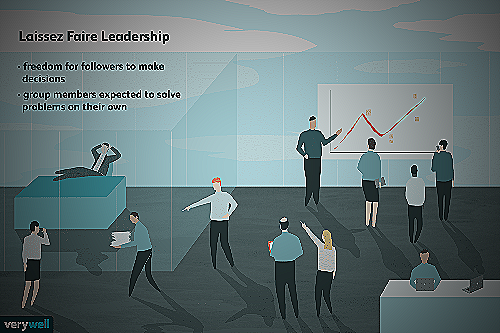Laissez Faire Leadership: Unleashing Freedom of Action
Laissez Faire Leadership is a management style that involves giving employees a high degree of autonomy to manage their own work. This leadership style is a complete opposite to micromanaging where managers closely monitor and control every aspect of their employee’s work.
Instead, Laissez Faire Leadership allows employees to have more freedom in their work, which can lead to more innovation and creativity.
By giving employees the space they need to manage their own work, leaders who use Laissez Faire Leadership can unleash the freedom of action that can help boost their team’s productivity and performance. In this article, we’ll explore more about what Laissez Faire Leadership is, how it can help you in the workplace, and what you need to know if you want to succeed as a Laissez Faire leader.
The Characteristics of Laissez Faire Leadership
Laissez Faire Leadership is characterized by giving employees the autonomy to make their own decisions and manage their work. Leaders who use this style focus more on managing the big picture instead of micromanaging their employees’ day-to-day tasks.
Check out this informative Youtube video about the benefits and drawbacks of Laissez-Faire Leadership that could benefit anyone in a managerial position or seeking to become a better leader.
Benefits of Laissez Faire Leadership
Laissez-faire leadership can bring various benefits to an organization. Here are some of them:
Increased autonomy
Laissez-faire leadership allows followers to take charge of their own work. Leaders who adopt this approach refrain from micromanaging their employees.
Thus employees can take ownership of their responsibilities and feel more empowered.
Enhanced creativity and innovation
Laissez-faire leaders do not dictate how tasks should be accomplished. Instead, they offer guidance and support as their followers take over.
This approach encourages independent thinking and risk-taking. Therefore, team members can come up with new approaches and innovate in ways they may not have with a traditional, top-down leadership approach.
Improved job satisfaction
Because laissez-faire leadership encourages freedom, team members feel more independent and confident to continue holding their own. With the ability to make decisions about their own work, they can find more meaning in their job, increasing job satisfaction – one of the critical factors of retaining employees.
Better time management
Laissez-faire leadership can help teams manage their time better. With the members possessing decision-making capabilities, tasks get completed more efficiently and effectively.
It allows individuals with expertise to determine how to best use their time and address the issues, leading to the successful delivery of work.

Characteristics of Laissez Faire Leadership
Laissez-faire leadership is a leadership style that is characterized by the hands-off approach. It involves allowing employees to make their own decisions and manage their own tasks with minimal intervention from the leader.
This management style is based on the belief that employees are capable of being self-motivated and productive without direct supervision.
One of the key characteristics of laissez faire leadership is delegation of responsibilities. Laissez-faire leaders trust their employees to complete their tasks without micromanagement.
They provide minimal direction and guidance, and instead, delegate tasks to specific individuals or departments. This allows team members to take ownership of their tasks and complete them in their own way.
Laissez-faire leaders also encourage open communication and feedback. They create an environment where employees feel comfortable sharing their ideas, feedback, and concerns.
This creates a sense of transparency and trust between the leader and their team.
Another important characteristic of laissez faire leadership is trust in employees. Laissez-faire leaders have faith in their team members’ abilities to make good decisions and complete their tasks effectively.
This trust encourages team members to be more independent and take ownership of their work.
Examples of Laissez Faire Leadership
Laissez-faire leadership style has been adopted by some of the world’s most successful business leaders. Some of the prime examples of laissez-faire leadership include:
- Steve Jobs at Apple Inc. Jobs was known for his hands-off leadership style, where he gave his employees autonomy to make their own decisions and create innovative products.
- Richard Branson at Virgin Group. Branson empowers his team to take risks and adopt a creative approach in their work. He believes in delegating tasks to his employees and allowing them to bring out their best potential.
- Warren Buffet at Berkshire Hathaway. Buffet is known for his trusting leadership style. He encourages his team to take the initiative and believes in delegating tasks to individuals who he trusts to get the job done right.

These leaders set goals, provide resources, and guide their team, but they leave decision-making and task management to individual team members. They build trust and confidence among their team and encourage them to be independent, productive, and innovative.
Drawbacks of Laissez Faire Leadership
Laissez-faire leadership may not be suitable for all occasions, despite its association with increased flexibility and independence amongst the team. Here, we detail some of the drawbacks of such an approach:
Lack of structure and supervision
The primary disadvantage of laissez-faire leadership is the lack of structure and direction for the team. Since the leader is hands-off, employees are left with no one to turn to for guidance when they need it.
As a result, employees may feel lost, unsupported, or underutilized. Without proper guidance, there is often a lack of clarity on organizational goals, expectations, and roles.
Difficulty in decision-making
Another drawback of laissez-faire leadership is that decision-making can be more difficult. With a hands-off approach, leaders may not provide clear decision-making criteria, which can lead to confusion or even conflict amongst team members.
A lack of clear goals can lead to a lack of motivation as well. Without clear goals, team members may be unsure of what they should be working on or even if their work is aligned with the organization’s goals.
Possible employee burnout
In the absence of clear direction and guidance, some employees may become overwhelmed by their workload. Without proper support and structure, it can be easy for employees to become overworked or burnt out as they try to make up for inadequate direction and supervision.
When employees burnout, it can lead to decreased productivity and a higher risk of turnover. Furthermore, the lack of supervision means that problems with underperformance or absenteeism can go unnoticed which will impact the organization’s bottom line in the long run.
When to Avoid Laissez Faire Leadership
Laissez-faire leadership can work for many situations, but are there instances when it should be avoided?
High-risk situations
In situations where safety is of the utmost concern, laissez-faire leadership should be avoided. In high-risk situations, the leader needs to be involved to ensure the safety of all team members.
The leader needs to oversee and give direction to the team to prevent any accidents or incidents.
Complex or urgent projects
When projects are complex or have tight deadlines, it is important for the leader to be hands-on. Complex projects require careful planning and execution, and the leader needs to be involved to ensure that everything will run smoothly.
Urgent projects need quick decision-making and immediate action, which a laissez-faire leader may not be able to provide.
Inexperienced or untrained employees
Laissez-faire leadership works well with employees who are experienced and trained. However, if employees are new to the job or lack the necessary training, the leader needs to be more involved to provide guidance and support.
Inexperienced employees need more direction and instruction to become productive members of the team.

Tips to Improve Laissez Faire Leadership
Laissez-faire leadership can be effective for employees who work independently or in creative positions. However, it may not work for everyone.
Here are some tips to improve laissez-faire leadership:
Establish clear expectations and deadlines
One of the main disadvantages of laissez-faire leadership is the lack of role clarity. To address this issue, leaders should clearly define each employee’s role, responsibilities, and deadlines.
This helps to ensure everyone is on the same page and that tasks don’t fall through the cracks.
Regularly check in with employees
Laissez-faire leadership doesn’t mean completely ignoring your team. Leaders should still check in with their team members regularly to ensure everything is on track, and to offer support if needed.
This helps to build trust, boost morale, and improve team performance.
Provide necessary resources and support
Laissez-faire leaders should ensure that their team members have all the resources and support they need to succeed. This includes providing access to training, tools, and any other resources that may be required to complete tasks effectively.
Encourage collaboration and feedback
While laissez-faire leadership gives employees more autonomy, this doesn’t mean that collaboration and feedback should be neglected. Encouraging team members to work together and provide feedback can help to improve performance and foster a more positive work environment.
Conclusion
Laissez Faire Leadership is a leadership style that values autonomy and independence among team members. While this leadership style has its advantages, leaders must be cautious of the disadvantages such as unclear roles, lack of direction, and new employees struggling to adjust.
To be an effective Laissez Faire Leader, it is essential to delegate tasks to the right people, provide sufficient resources, and offer constructive criticism. Observing team performance, addressing problems, and creating incentives are also helpful in maintaining team productivity.
Ultimately, Laissez Faire Leadership can be a valuable leadership style in the right circumstances, but it requires careful consideration and management. Leaders who balance autonomy with structure can unleash the full potential of their teams.
References
- Laissez-Faire Leadership
- Laissez-Faire Leadership Guide: Definition, Qualities, Pros & Cons, Examples
- The Pros and Cons of

